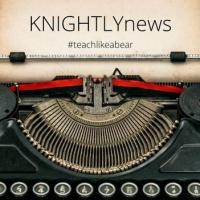The KNIGHTLYnews is an online forum where FWS instructors and other teachers of writing can swap and share ideas for best classroom practice. Weekly posts are designed to help teachers develop lesson plans and writing assignments, and respond to classroom challenges by introducing new teaching tools and sharing emerging pedagogical ideas. Posts also direct readers to program and campus resources that support teaching and learning, and provide opportunities for peer collaboration and mentorship. #teachlikeabear
PMA 1161, Food & the Media, explores the burgeoning arena of Food Writing in a number of academic and public-facing contexts. For the Fall 2023 iteration of the class, I wanted to introduce a short unit on ChatGPT to allow students to see its limitations for their academic writing, as well as what it can offer them as a developmental tool.
I decided to use the unit on Food Criticism for this purpose. In previous offerings of this class, students had read leading food critics, and we analyzed and discussed their work as models. We looked at this form of writing, structurally and stylistically, to explore content building blocks as well as features such as tone and use of descriptive detail. Students then wrote their own food criticism, based on their experiences at dining halls, or local restaurants, or eateries elsewhere that they had recently visited.
For Fall 2023, I maintained the reading and analysis of food critics’ writing. I consulted with the manager of Taverna Banfi at the Statler Hotel on campus to secure permission for the class to visit the restaurant. Students were asked to make notes on their visit, observing the décor and layout of the restaurant, and to pay particular attention to details of the menus (the offerings, their descriptions, their prices, etc.).
After their “field trip,” I devoted a class session to how ChatGPT would generate reviews of Taverna Banfi: on its own, and then in the style of two prominent restaurant critics whose writing the students had already read: Soleil Ho of the San Francisco Chronicle and Pete Wells of the New York Times.
The reviews generated by ChatGPT were laughable at best—especially the emojis it chose to insert in the pieces modeled on the work of Ho and Wells. The initial review emerged as bland, generic, and inaccurate. Students quickly grasped how the AI-generated pieces could emulate the structure and basic content of a review, but noted the writing was formulaic and non-specific at many points. It was clear that the ChatGPT system was making assumptions about the restaurant’s menu, décor, and ambience, based on the name of the restaurant alone; other details it inserted about amenities were simply wrong.
As we discussed what Chat GPT had generated, the students noted how the system brought to the fore the structural elements they could use as building blocks. They also quickly understood the distinctions between the elegance, specificity, and precision of the professional critics’ writing and that of the AI-generated prose, which lacked nuance and color.
Very recently, Pete Wells wrote a piece in the Times about AI-generated reviews: “The Chef Is Human. The Reviewer Isn’t” (June 24, 2024). The article discusses a research project by a professor at Yale who wanted to see if readers could distinguish a human-authored Yelp review from an AI-generated review. I plan to have my students read this essay after we do our own ChatGPT exercise—we’ll see if they emerge as more astute readers than those summarized in these research findings!
Professor, Performing and Media Arts, Cornell University



